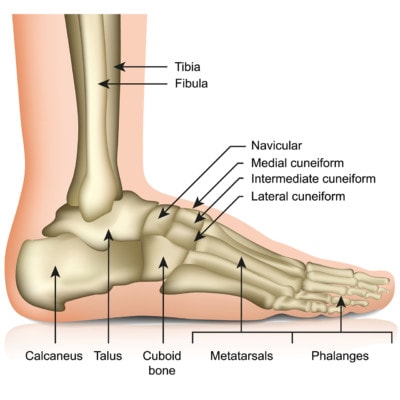Foot Arch Knee Pain? Research Links Your Foot Navicular Bone Position to Your Knee
Can you have foot arch knee pain? Yesterday I watched the inaugural Boulder Iron man Race. As the runners filed by, I couldn’t help but notice their gait. In some, according to a new study, not paying attention to a little bone in their feet may be frying the cartilage in their knees.
First, as I watched this awe inspiring race yesterday, I saw more running styles than I could count. There was some beautiful symmetry in many of the high level participants and some disturbing asymmetry in many others. To learn more about why this asymmetry will likely predict which of these triathletes get injured in the future and which may be having a hard time walking today, read our practice’s e-book Orthopedics 2.0, and explore a real-world example in our case study on stem cell treatment for an Ironman triathlete.

Medicalstocks/Shutterstock
Second, this morning I’d like to focus on running problems that begin in the feet. The navicular is a bone at the top of the arch or “keystone” that holds up your foot, but most runners have never heard of this little bone. The arch in your foot is the shock absorber that allows you to have “spring” in your step. So as you might imagine, those runners with a strong arch and a well functioning navicular bone use less energy when they run, because the arch stores that energy efficiently and then provides it back in the form of that “spring”.
The navicular bone can “drop” as the arch collapses with standing or running and is associated with excessive pronation of the foot. This can happen in the worse cases due to structural changes in the bone, but more commonly it’s due to atrophy of the muscles that hold up the arch. The navicular bone is in red in the picture above. Note that there are lines going horizontally under the arch that represent the muscles and ligaments (including the plantar fascia) that support the arch.
The new study looked at how much this bone dropped while the foot hit the ground running versus bio mechanical changes in the foot, ankle, and knee. Not surprisingly, small amounts of drop in the navicular (and arch) had profound impacts all the way up to the knee. In a race like an Iron Man triathlon, the foot strikes the ground more than 25,000 times, so all of these extra forces add up.
What can you do if your arch collapses when you run? For starters, simple foot exercises to strengthen the intrinsic foot muscles that help hold up the arch is a good start. Second, we see a lot of patients with low level nerve irritation in their low back as a cause of intrinsic foot muscle atrophy, so your low back may also need to be treated. Finally, if all else fails, orthotics may be an option.
The upshot? The navicular bone is a big deal. It should move normally and the arch that it structurally supports shouldn’t collapse when you stand or run. If you have knee problems when running, taking a look at how this arch behaves with running is something to consider as a possible cause.

If you have questions or comments about this blog post, please email us at [email protected]
NOTE: This blog post provides general information to help the reader better understand regenerative medicine, musculoskeletal health, and related subjects. All content provided in this blog, website, or any linked materials, including text, graphics, images, patient profiles, outcomes, and information, are not intended and should not be considered or used as a substitute for medical advice, diagnosis, or treatment. Please always consult with a professional and certified healthcare provider to discuss if a treatment is right for you.
